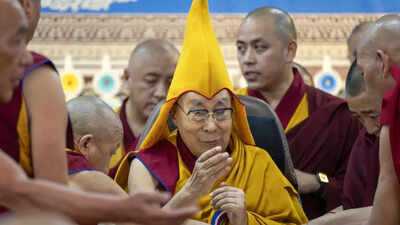Dalai Lama succession dispute: Understanding who he is, how his successor is chosen, and what students need to know about growing tensions

The Dalai Lama is not only a globally recognised figure of peace and compassion but also the spiritual head of Tibetan Buddhism. For many, he symbolises the preservation of Tibetan culture and religious identity in exile. The current 14th Dalai Lama, based in India since fleeing Tibet in 1959, has long been at the centre of a delicate political and religious balance, especially between India and China.As the 14th Dalai Lama advances in age, attention has turned to the sensitive question of his successor. This issue is not merely spiritual but heavily political, with China and Tibet’s exiled leadership offering starkly different visions. The Dalai Lama has made it clear that the Chinese government has no role to play in selecting his successor, igniting fresh tension with Beijing.Who is the Dalai Lama and why does his succession matter?The Dalai Lama is believed to be the reincarnation of Avalokiteshvara, the Bodhisattva of Compassion. Each Dalai Lama is considered a “Living Buddha”, whose soul is reborn in a new child after his death. The process of identifying the reincarnation involves a range of spiritual signs, visions, and consultations by senior Tibetan monks.The current Dalai Lama, the 14th in the line, fled to India in 1959 after a failed uprising in Tibet. Since then, he has lived in exile in Dharamshala, where the Tibetan government-in-exile is based.His influence is not just spiritual but also political, although he stepped down from political responsibilities in 2011, handing over authority to the elected Tibetan leadership. Despite this, Beijing often attributes political motives to his religious activities and has objected to his visits to Indian states like Arunachal Pradesh, which China claims as part of its territory.In contrast, the Chinese state enforces a more regulated and political process involving the Golden Urn, a system introduced in 1792 by the Qing dynasty. This method requires drawing lots from a gilded urn containing names of potential successors. According to Beijing, this process ensures authenticity and is backed by centuries of tradition and legal authority.A deeply political process cloaked in religious traditionWhile the Dalai Lama has previously stated that his next reincarnation could be born among his followers in India, China insists that any legitimate successor must be born within China and selected through the Golden Urn method. The Chinese ambassador to India, Xu Feihong, recently reaffirmed that the reincarnation of the Dalai Lama and other Tibetan lamas must comply with “religious rituals and historical conventions as well as Chinese laws and regulations.”Beijing has warned that bilateral ties with India could suffer if New Delhi refuses to accept its chosen successor. Although India has long hosted the Tibetan government-in-exile and offers the Dalai Lama asylum, it has refrained from making official statements on the issue. By contrast, the U.S. has declared that reincarnation is a matter of religious freedom, not state authority, and has threatened to raise the matter at the UN.Implications for India–China relationsIndia, home to the Dalai Lama and the Tibetan exile community, has so far remained silent on the issue. Unlike the U.S., which sees the succession as a matter of religious freedom and human rights, India has chosen to stay neutral, likely to avoid diplomatic fallout with China.However, Beijing has previously warned that ignoring the “traditional” selection process could strain bilateral ties. A Chinese research delegation in 2019 cautioned Indian journalists that no “wise leader” would challenge China’s role in the process, but suggested India could simply stay neutral without endorsing the Chinese choice.The succession issue could become another flashpoint in Sino-Indian ties, especially given recent efforts to improve bilateral relations. Past events, such as the Dalai Lama’s visit to Arunachal Pradesh followed by the Doklam standoff, demonstrate how quickly religious matters can escalate into geopolitical disputes.Why students should care about this issueFor students, the Dalai Lama succession dispute highlights the complex relationship between religion, politics, and international diplomacy. It also offers insight into how historical traditions are sometimes used to assert state power, and how countries like India and China navigate sensitive cultural and geopolitical matters.Understanding the implications of the Dalai Lama’s succession dispute offers students more than just insight into a religious tradition—it provides a valuable lens through which to examine how religion, identity, and political power intersect on the global stage. This issue highlights not only the historical and spiritual significance of the Dalai Lama’s role, but also the broader themes of diplomacy, cultural preservation, and the tensions that arise when state authority seeks to influence deeply personal and sacred matters. For students, following this story is an opportunity to engage critically with international affairs and explore the complex dynamics between faith and governance in today’s world.





